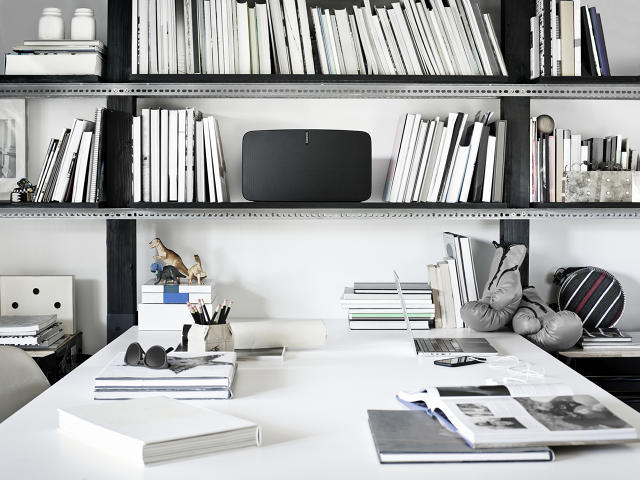The Sonos Play:5 Smart Speaker Will Sound Good No Matter Where You Put It
Later this fall, Sonos will ship the all-new Play:5 smart speaker with a new feature that will let you tune the speaker’s sound to any room.
One of the perks of Sonos products is also one of their biggest pitfalls: They’re compact and aesthetically unobtrusive enough to go anywhere in your home. On a bookshelf. Next to the refrigerator. Some people even put them behind the sofa. It’s convenient, but the sonic implications can be enough to drive any acoustic engineer out of their mind. Soon, this awkward tension between sound and aesthetics may be relieved.
Today, Sonos is announcing the latest addition to its lineup of wireless, high-fidelity smart speakers: the new Play:5. The device packs six drivers, three mid-woofers, and three tweeters for maximum sonic clarity across a wide range of tones, from the deepest bass on a Kanye West record to the highest note ever sung by opera star Maria Callas.
We had a chance to hear the speaker in action and it has a spatially mixed, ultra-clear and detailed sound that non-audiophile consumers aren’t accustomed to hearing at home. And when it’s paired with another Play:5 (they go for $500 apiece), the sonic range gets even more expansive, filling just about any room with remarkable sound.
“Everything is redesigned from scratch,” says Jon Reilly, the senior product manager for the Play:5. “We didn’t reuse anything.”

Each Play:5 contains an accelerometer that tells the speaker whether its placed vertically or horizontally (its aesthetic design and the placement of its new, multitouch volume and play buttons allow for either orientation). If it’s the latter, the speaker will distribute sound using a much wider stereo array, allowing it to fill the room with sound more thoroughly. Pairing two Play:5’s as a stereo pair and placing on their sides results in an ultra-wide, immersive soundscape that it’s hard to imagine ever coming out of a Bluetooth speaker.
Features like this, combined with its sleek, minimalist design, make the new Play:5 an impressive enough product, but the speaker’s most interesting detail is a feature that won’t even work when it ships later this fall.
Built into every Play:5 is a tiny microphone. Although it won’t be active on day one, it’s clear what the company plans to use it for: Down the line, it’s going to become yet another sensor in our increasingly smart homes. In this case, the microphone will be used to help Sonos’s speaker read sound waves in the room and better understand where it’s located in the room and what that room looks like.
The first iteration of this technology is called TruePlay, and it’s also being announced today. Although instead of relying on microphones embedded into speakers (existing Sonos products don’t have this feature), TruePlay will use the microphone built into your iPad or iPhone to take an acoustic measurement of the room and then automatically tune the speakers to that space.
It works like this: Once TruePlay rolls out to the Sonos app for iOS (its exact launch date has yet to be announced), anybody with any Play:1, Play:3, or Play:5 speaker can hit the TruePlay button, which will send a series of sonic pulses throughout the room from each speaker (it sounds a bit like an intergalactic warship firing its lasers through space in a sci-fi movie). As this happens, you’ll slowly wave your iOS device up and down and walk around the room, kind of like a sound wizard casting a spell on your own house. Yes, this is a strange thing to do, but the results will most likely be worth it.
Once this process is complete (it takes about a minute or so), the speakers will retune themselves based on the physical layout and acoustic properties of the room. This is the kind of stuff audiophiles have been doing with specialized gear for years, only now it’s built into your smartphone.
The results will vary depending on the placement of the speakers in a given room. For some, there won’t be much discernible difference. For others, especially those with speakers on shelves or under furniture, the difference in sound can be dramatic. To illustrate TruePlay with a more extreme example, the company gave a demo in which one Play:1 speaker was placed next to a refrigerator and the other was actually put inside of a closed kitchen cabinet. With TruePlay off, you could certainly tell that one of the speakers was in the cabinet. With TruePlay on, the room sounded more like a nightclub.
At launch, TruePlay will only work on iOS devices, only because there’s too much variance in the quality of the microphones on Android devices. “Even the same Android phone on a different carrier network will show a different response,” says Michael Papish, the director of platform marketing at Sonos. “There’s a lot of calibration effort required to make sure we know what each mic is and how it operates.”
Sonos engineers are indeed working on an Android-based version of TruePlay, but it may take some time. Hence their decision to build a microphone directly into the Play:5 for future purposes. Thankfully, about 80% of Sonos-owning households have an iOS device. And in all likelihood, residents of the other 20% know people with iPhones.
“Our plan is just have you invite a friend around,” jokes Giles Martin, sound experience leader at Sonos.
Fast Company , Read Full Story
(106)














